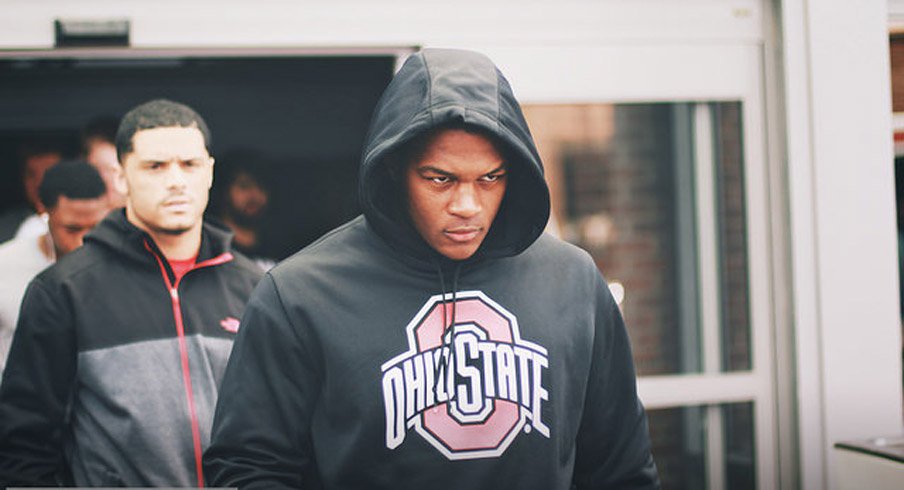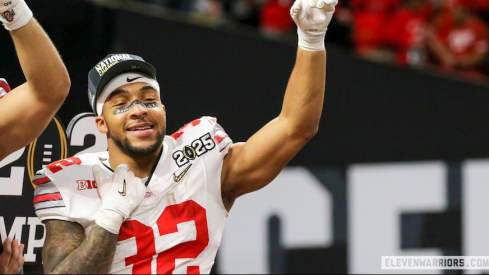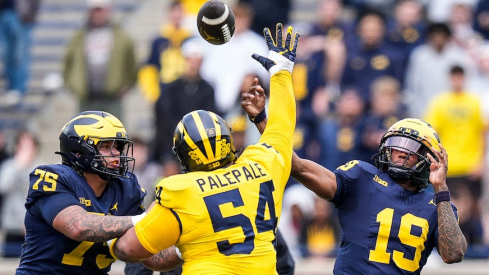A few days after Ohio State’s annual Spring Game in April, freshman linebacker Raekwon McMillan offered the world a tweet that doubles as a challenge and a credo:
Some Do ... Some Don't #Shine http://t.co/6Qbz7q7wUj
— Raekwon McMillan (@Kwon_daTRUTH) April 17, 2014
Meaning, some players can handle the kind of pressure that comes with being one of the nation’s most prized recruits, and some don’t. Some players rise up to meet lofty – and often unfair – expectations, and some don’t. Some players live up to their potential, and some don’t.
For McMillan, who came to Columbus as a five-star recruit and the top-ranked linebacker in the country last winter, this is a mountain he must stare at each and every day despite gaining the gushing approval of head coach Urban Meyer.
Because for him and other big-time college football recruits across the land, powerhouse schools like Ohio State become an intersection of reality and expectations. Year after year, the Buckeyes haul in crops of high school players brimming with talent. They're bedazzled with every award and accolade possible. Year after year, these classes, full of four and five-star athletes, rank among the nation's best. And year after year, said classes will yield at least a handful of kids who fall well below the hype that accompanied them to college.
It's not a novel concept, of course, but it remains an intriguing one for schools that consider recruiting its lifeblood: why do some big-time prospects blossom and why do others leave school with the dreaded label of being bust?
"That’s the million dollar question, that’s what we’re all trying to find out," Meyer said at Big Ten Media Days two weeks ago.
And for the Buckeyes, who tirelessly invest so much time and effort into the players they want walking inside the hallways of the Woody Hayes Athletic Center, it's worth trying to find out an answer.
"You see the NFL Draft every year and guys are getting drafted from small schools or they’re unheard of," Meyer said, "and then five-star guys disappear."
In this world, stars handed to players by recruiting services measure potential and measure worth. Conventional wisdom suggests a five-star kid is better than two-star kid. But maybe it shouldn't be that way.
"It’s all a number, man. Any guy can beat out any guy in any situation," senior quarterback and former four-star prospect Braxton Miller said. "You never want to overthink somebody got two stars and somebody who got four stars that the four-star guy is better than two-star."
Meyer and Co. alleviate such a conundrum by furiously vetting targets.
"There’s some ways we try to find out. It’s hard for me because I’m not allowed to go out, it’s the (assistant) coach that goes in and does his work that asks the hard questions that comes back to me and says, he’s a five-star...but," Meyer said before making scrunching up his face and shaking his head.
But there's also a certain onus that falls upon the players. After all, you can lead a horse to water, but you can't make him drink it.
"You don’t have to be a genius to play football at the college level but you do have to really pay attention to what’s going on," senior defensive lineman and former four star Michael Bennett said. "So I would say maturity and then the ability to learn (are the biggest things). Most five stars that you see coming out of college that have made it as you would say, those guys are probably going to be pretty intelligent and they’re gonna be really hard workers.
"The five stars that don’t pan out, either they got hurt -- and that just happens -- or they’ve been very resistant to their coaches. And I’d say probably resistance is pretty bad for them."
But that, Meyer said, is the coach's fault in the first place.
"Those are all things our coaches should find out on their own," he said. "Because it didn’t just show up. It’s usually an assistant coach who didn’t do his job right."
Part of that job is a seemingly never-ending quest of evaluating talent at summer camps, high school football games and everything in between. Before the players ever take the field on Saturdays in mighty places like Ohio Stadium, games are won and lost here.
"One thing that I like to do: how does he play in his rivalry game? How winded is he in the fourth quarter against a good team to win a championship. That’s what I try to personally watch, because those are the ones that usually turn out fantastic," Meyer said. "The five-star that pulls his hamstring every year before a rivalry game or gets shut out, you’re like, why did that happen? But it takes time."
In a world where everything is an arms race and recruiting is a 24/7, 365-day grind, time is a luxury few can afford. Like McMillan said, "some do, some don't." You better get it right.


